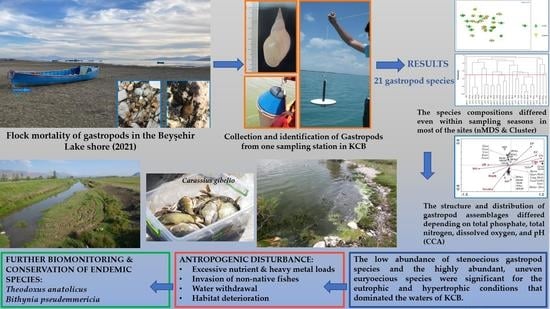Towards a Sustainable World: Diversity of Freshwater Gastropods in Relation to Environmental Factors—A Case in the Konya Closed Basin, Türkiye
Abstract
1. Introduction
2. Materials and Methods
2.1. Study Area
2.2. Collection and Identification of Gastropods
2.3. Counting Gastropods
2.4. Ecological Evaluation
2.5. Environmental Variables
2.6. Statistical Methods
3. Results
3.1. In General
3.2. In Lotic Stations
3.2.1. Similarities of Lotic Stations
3.2.2. CCA results of lotic stations
- Valvata piscinalis and A. balthica had a positive correlation with total nitrogen.
- Theodoxus fluviatilis, G. albus, Gyraulus piscinarum, Galba truncatula, A. balthica, with high frequency values had a positive correlation with alkalinity, and P. acuta and Bathyomphalus contortus with temperature.
- Viviparus viviparus and P. antipodarum had a negative correlation with total phosphorus and total nitrogen.
3.3. In Lentic Stations
3.3.1. Similarities of Lentic Stations
3.3.2. CCA Results of Lentic Stations
- Ampullaceana balthica had a positive correlation with water temperature and Secchi disc transparency as shown at Figure 6.
- Planorbis planorbis, G. truncatula, and S. palustris had a positive correlation with chlorophyll a, and total nitrogen.
- Existence of V. viviparus and Physa fontinalis were positively correlated with increasing levels of pH and DO.
- According to the CCA triplot, species and lentic sites clustered into three groups. The first group included all seasons of Beyşehir and İvriz, as well as the summer season of İbrala. The species composition of the first group had a positive correlation with temperature and Secchi disc. The second group consisted of only Akkaya and its species composition. The gastropod presence of Akkaya was directly correlated with chlorophyll a, and total nitrogen. The third group consisted of the spring and fall seasons of İbrala, and all seasons of Suğla, Mamasın, and Gödet. The species composition of the third group was located distantly from temperature and other nutrients (Figure 6).
4. Discussion
5. Conclusions
Suggestions
Author Contributions
Funding
Institutional Review Board Statement
Acknowledgments
Conflicts of Interest
References
- Gürlek, M.E.; Şahin Koşal, S.; Dokumcu, N.; Yıldırım, M.Z. Checklist of the Freshwater Mollusca of Turkey (Mollusca: Gastropoda, Bivalvia). Fres. Environ. Bull. 2019, 28, 2992–3013. [Google Scholar]
- Yıldırım, M.Z. Türkiye Prosobranchia (Gastropoda: Mollusca) Türleri ve Zoocoğrafik Yayılışları, 1. Tatlı ve Acı Sular. Turkish J. Zool. 1999, 23, 877–900. (In Turkish) [Google Scholar]
- Yıldırım, M.Z.; Gümüş, B.A.; Kebapçı, Ü.; Koca Bahadır, S. The Basommatophoran Pulmonate Species (Mollusca: Gastropoda) of Turkey. Turkish J. Zool. 2006, 30, 445–458, ISSN: 1300–0179. [Google Scholar]
- Seddon, M.; Lopes-Lima, M.; Kebapçı, Ü.; Van Damme, D.; Smith, K. Freshwater Molluscs. In The Status and Distribution of the Freshwater Biodiversity of the Mediterranean; Smith, K., Barrios, V., Darwall, W., Numa, C., Eds.; IUCN: Cambridge, UK; Malaga, Spain; Gland, Switzerland, 2014. [Google Scholar] [CrossRef]
- MolluscaBase. MolluscaBase. 2022. Available online: https://www.molluscabase.org (accessed on 6 September 2022). [CrossRef]
- Gümüş, B.A.; Neubert, E. The Biodiversity of the Terrestrial Malacofauna of Turkey-Status and Perspectives. Zookeys 2009, 31, 105–117. [Google Scholar] [CrossRef]
- Çabuk, Y.; Arslan, N.; Yılmaz, V. Species composition and seasonal variations of the Gastropoda in Upper Sakarya River System (Turkey) in relation to water quality. Acta Hydro. Hydrob. 2004, 32, 393–400. [Google Scholar] [CrossRef]
- Akbulut, M.; Kaya, H.; Çelik, E.Ş.; Odabaşı, D.A.; Odabaşı Sağır, S.; Selvi, K. Assessment of Surface Water Quality in the Atıkhisar Reservoir and Sarıçay Creek (Çanakkale, Turkey). Ekoloji 2010, 19, 139–149. Available online: https://search.trdizin.gov.tr/yayin/detay/101956/ (accessed on 18 September 2022). [CrossRef]
- Şahin Koşal, S.; Zeybek, M. Distribution of Mollusca Fauna in the Streams of Tunceli Province (East Anatolia, Turkey) and its Relationship with Some Physicochemical Parameters. Turkish J. Fish. Aquat. 2016, 16, 187–195. [Google Scholar] [CrossRef]
- Karakaş, S.B.; Otludil, B. Accumulation and histopathological effects of cadmium on the great pond snail Lymnaea stagnalis Linnaeus, 1758 (Gastropoda: Pulmonata). Environ. Toxicol. Pharmacol. 2020, 78, 103403. [Google Scholar] [CrossRef]
- Bal, D.; Odabaşı, D.A.; Zilifli, A. Determination of Mollusca Fauna and Some of The Water Quality Features of Kavak Stream (Gelibolu Peninsula: Çanakkale). Adv. Res. Nat. Appl. Sci. 2021, 7, 393–407. [Google Scholar] [CrossRef]
- Altındağ, A.; Solak, C.N.; Körüklü, S.T.; Ergönül, M.B.; Ertorun, N.; Altınöz, M.; Güney, K.; Tekatlı, Ç. Project on Monitoring and Determination of Reference Points of Konya Closed Basin Report; Segal Environmental Measurement and Analysis Laboratory Engineering Consultancy Ltd.: Ankara, Turkey, 2014; (SGYM/ 33.01.32.00/ 2014). (In Turkish) [Google Scholar]
- Lu, Y.; Wang, R.; Zhang, Y.; Su, H.; Wang, P.; Jenkins, A.; Ferrier, R.C.; Bailey, M.; Squire, G. Ecosystem health towards sustainability. Ecosyst. Heal. Sustain. 2015, 1, 1–15. [Google Scholar] [CrossRef]
- Omer, N.H. Water Quality Parameters. In Water Quality—Science, Assessments and Policy; Summers, K., Ed.; IntechOpen: London, UK, 2019. [Google Scholar] [CrossRef]
- Woolway, R.I.; Kraemer, B.M.; Lenters, J.; Merchant, C.J.; O’Reilly, C.M.; Sharma, S. Global Lake responses to climate change. Nat. Rev. Earth Environ. 2020, 1, 388–403. [Google Scholar] [CrossRef]
- Singh, G.; Singh, A.; Singh, P.; Mishra, V.K. Impact of climate change on freshwater ecosystems, Chapter 4. In Water Conservation in the Era of Global Climate Change; Thokchom, B., Qiu, P., Singh, P., Iyer, P.K., Eds.; Elsevier: Amsterdam, The Netherlands, 2021; pp. 73–98. ISBN 9780128202005. [Google Scholar] [CrossRef]
- Fortunato, H. Mollusks: Tools in Environmental and Climate Research. Amer. Malacol. Bull. 2015, 33, 1–15. [Google Scholar] [CrossRef]
- Vukašinović-Pešić, V.; Blagojević, N.; Vukanović, S.; Savić, A.; Pešić, V. Heavy Metal Concentrations in Different Tissues of the Snail Viviparus mamillatus (Küster, 1852) from Lacustrine and Riverine Environments in Montenegro. Turkish J. Fish. Aquat. 2017, 17, 557–563. [Google Scholar] [CrossRef]
- Tallarico, L.D.F. Freshwater Gastropods as a Tool for Ecotoxicology Assessments in Latin America. Amer. Malacol. Bull. 2015, 33, 330–336. [Google Scholar] [CrossRef]
- Martín, P.R. Evidence for parthenogenesis and natural imposex in the Patagonian freshwater snail Heleobia hatcheri (Gastropoda: Hydrobiidae). J. Molluscan Stud. 2002, 68, 291–295. [Google Scholar] [CrossRef][Green Version]
- Zou, E. Aquatic Invertebrate Endocrine Disruption. In Animal Behaviour; Choe, J.C., Ed.; Elsevier: Amsterdam, The Netherlands, 2019; pp. 470–482. ISBN 978-0-12-813252-4. [Google Scholar]
- Strong, E.E.; Gargominy, O.; Ponder, W.; Bouchet, P. Global diversity of Gastropods (Gastropoda; Mollusca) in freshwater. Hydrobiologia 2008, 595, 149–166. [Google Scholar] [CrossRef]
- Smitha, S.; Mustak, M.S. Gastropod diversity with physico-chemical characteristics of water and soil in selected areas of Dakshina Kannada district of Karnataka, India. Int. J. Fauna Biol. 2017, 4, 15–21. [Google Scholar]
- Baroudi, F.; Al Alam, J.; Fajloun, Z.; Millet, M. Snail as sentinel organism for monitoring the environmental pollution; A review. Ecol. Ind. 2020, 113, 16240. [Google Scholar] [CrossRef]
- Kan, M.; Oğuz, C.; Kan, A.; Ergun, H.; Demiroz, E. Multidimensions of Poverty for Agricultural Community in Turkey: Konya Province Case. Pak. J. Agric. Sci. 2018, 55, 227–238. [Google Scholar]
- TSWQR. 2012; Surface Water Quality Regulation, Resmî Gazete Tarihi: 30 November 2012. Resmi Gazete Sayısı: 28483. (In Turkish). Available online: https://www.mevzuat.gov.tr/mevzuat?MevzuatNo=16806&MevzuatTur=7&MevzuatTertip=5 (accessed on 18 July 2022).
- Kunt, M.; Gürbüzler, D.; Erkal, İ.F.; Hacıhasanoğlu, S.; Özer, E. State of the Environment Report for the Republic of Turkey; Republic of Turkey Ministry of Environment and Urbanisation: Ankara, Turkey, 2016; p. 315. ISBN 978-605-5294-53-3. Available online: http://www.csb.gov.tr/gm/ced (accessed on 20 July 2022).
- Gülesin Salmaner, E. Integrated Water Resource Management Planning: The Case of the Konya Closed Basin. Master’s Thesis, Biology Department, Middle East Technical University, Ankara, Turkey, 2008. Available online: https://etd.lib.metu.edu.tr/upload/12610163/index.pdf (accessed on 27 August 2022).
- Bucak, T. The Impacts of Climate Change and Land Use on the Ecosystem Structure and Services of Lake Beyşehir. Ph.D. Thesis, Biology Department, Middle East Technical University, Ankara, Turkey, 2017. Available online: https://etd.lib.metu.edu.tr/upload/12620912/index.pdf (accessed on 28 September 2022).
- Altındağ, A.; Yiǧit, S. Assessment of heavy metal concentrations in the food web of lake Beyşehir, Turkey. Chemosphere 2005, 60, 552–556. [Google Scholar] [CrossRef]
- Elhatip, H.; Güllü, Ö. Influences of wastewater discharges on the water quality of Mamasın dam watershed in Aksaray, Central Anatolian part of Turkey. Environ. Geol. 2005, 48, 829–834. [Google Scholar] [CrossRef]
- Tekin Ozan, S. Determination of heavy metal levels in water, sediment and tissues of tench (Tinca tinca L., 1758) from Beyşehir Lake (Turkey). Environ. Monit. Ass. 2008, 145, 295–302. [Google Scholar] [CrossRef] [PubMed]
- Özparlak, H.; Arslan, G.; Arslan, E. Determination of Some Metal Levels in Muscle Tissue of Nine Fish Species from Beyşehir Lake, Turkey. Turkish J. Fish. Aquat. 2012, 12, 761–770. [Google Scholar] [CrossRef]
- Mackie, G.; Morris, T.J.; Ming, D. Protocol for the detection and relocation of freshwater mussel species at risk in Ontario-Great Lakes Area (OGLA). Can. Manuscr. Rep. Fish. Aquat. Sci. 2008, 2790, 50. [Google Scholar]
- ISO. Sampling (general methods; TC 147/SC 6/ WG 1, 3). 1982. Available online: https://www.iso.org/committee/52994.html (accessed on 18 July 2022).
- ISO. Water quality (ISO 10870: 2012)— Guidelines for the selection of sampling methods and devices for benthic macroinvertebrates in fresh waters. 2012. Available online: https://www.iso.org/standard/46251.html (accessed on 18 July 2022).
- Cummings, K.; Jones, H.; Lopes-Lima, M. Rapid Bioassessment Methods for Freshwater Molluscs. In Core Standardised Methods for Rapid Biological Field Assessment; Larsen, T.H., Ed.; Conservation International: Washington, DC, USA, 2016; pp. 185–207. ISBN 978-1-934151-96-9. [Google Scholar]
- Schütt, H. Zur Systematik und Ökologie Türkischer Süßwasser Prosobranchier. Zool. Med. 1965, 41, 44–72. [Google Scholar]
- Welter-Schultes, F.W. European Non-Marine Molluscs, A Guide for Species Identification; Planet Poster Editions: Göttingen, Germany, 2012; pp. A1–A3, 1–679, Q1–Q78. [Google Scholar]
- Glöer, P. The Freshwater Gastropods of the West-Palaearctis. In Fresh- and Brackish Waters Except Spring and Subterranean Snails; Identification key, Anatomy, Ecology, Distribution; Biodiversity Research Lab: Hetlingen, Germany, 2019; Volume 1, p. 399. [Google Scholar]
- Mariotte, P. Do subordinate species punch above their weight? Evidence from above- and below-ground. New Phyt. 2014, 203, 16–21. [Google Scholar] [CrossRef]
- Mouthon, J.; Charvet, S. Compared sensitivity of species, genera, and families of Molluscs to biodegradable pollution. Ann. de Limnol. Int. J. Limnol. 1999, 35, 31–39. [Google Scholar] [CrossRef]
- Hubenov, Z. Fauna and zoogeography of marine, freshwater, and terrestrial mollusks (Mollusca) in Bulgaria. In Biogeography and Ecology of Bulgaria; Fet, V., Popov, A., Eds.; Springer: Dodrecht, The Netherlands, 2007; pp. 141–198. [Google Scholar]
- ISO. Biological Methods (ISO 147/ SC 5). 1980. Available online: https://www.iso.org/committee/52972.html (accessed on 18 July 2022).
- ISO. Water Quality (ISO 8689-1:2000). Biological Classification of rivers-Part 1: Guidance on the Interpretation of Biological Quality Data from Surveys of Benthic Macroinvertebrates. 2000a. Available online: https://www.iso.org/standard/28368.html (accessed on 18 July 2022).
- ISO. Water Quality (ISO 8689-2:2000). Biological Classification of rivers- Part 2: Guidance on the Interpretation of Biological Quality Data from Surveys of Benthic Macroinvertebrates. 2000b. Available online: https://www.iso.org/standard/28369.html (accessed on 18 July 2022).
- Ter Braak, C.J.F. Canonical Correspondence Analysis: A new eigenvector technique for multivariate direct gradient analysis. Ecology 1986, 67, 1167–1179. [Google Scholar] [CrossRef]
- Leps, J.; Similaur, P. Multivariate Analysis of Ecological Data Using CANOCO; Cambridge University Press: Cambridge, UK, 2003. [Google Scholar]
- Clarke, K.R.; Warwick, R.M. Change in Marine Communities: An Approach to Statistical Analysis and Interpretation, 2nd ed.; PRIMER-E: Playmouth, UK, 2001. [Google Scholar]
- Bray, R.J.; Curtis, J.T. An ordination of the upland forest communities of southern Wisconsin. Ecol. Monogr. 1957, 27, 325–349. [Google Scholar] [CrossRef]
- Shannon, C.E.; Weaver, W. The Mathematical Theory of Communication; The University of Illinois Press: Urbana, IL, USA, 1949; pp. 1–117. [Google Scholar]
- Margalef, R. Diversidad de species en las commundales naturals. P. del Inst. de Biol. Ap. 1951, 6, 59–72. [Google Scholar]
- Pielou, E.C. Ecological Diversity; Wiley-InterScience: New York, NY, USA, 1975; p. 165. [Google Scholar]
- Soyer, J. Bionomie benthique du plateau continental de la cote catalana Française, III. Les Peuplements de Copepodes Harpacticodies (Crustacea). Vie Mlieu 1970, 21, 377–511. [Google Scholar]
- Bellan-Santini, D. Contribution des peuplement infralittoraux sur substrat rocheux (Etude qualitative et quantitative de la franch Superiere). Rech.Trav. St. Mar. End. 1969, 63, 9–294. [Google Scholar]
- Aksenova, O.V.; Bolotov, I.N.; Gofarov, M.Y.; Kondakov, A.V.; Bespalaya, Y.V.; Kolosova, Y.S.; Sokolova, S.E.; Spitsyn, V.M.; Tomilova, A.A.; Travina, O.V.; et al. Species Richness, Molecular Taxonomy and Biogeography of the Radicine Pond Snails (Gastropoda: Lymnaeidae) in the Old World. Sci. Rep. 2018, 8, 11199. [Google Scholar] [CrossRef] [PubMed]
- Spyra, A.; Cieplok, A.; Strzelec, M.; Babczyńska, A. Freshwater alien species Physella acuta (Draparnaud, 1805)—A possible model for bioaccumulation of heavy metals. Ecotox. Environ. Saf. 2019, 185, 109703, ISSN 0147-6513. [Google Scholar] [CrossRef]
- Gust, M.; Buronfosse, T.; Geffard, O.; Coquery, M.; Mons, R.; Abbaci, K.; Giambérini, L.; Garric, J. Comprehensive biological effects of a complex field polymetallic pollution gradient on the New Zealand mudsnail Potamopyrgus antipodarum (Gray). Aquat. Toxicol. 2011, 1, 100–108. [Google Scholar] [CrossRef]
- Höckelmann, C.; Pusch, M. The respiration and filter-feeding rates of the snail Viviparus viviparus (Gastropoda) under simulated stream conditions. Arch. fur Hydrobiol. 2000, 149, 553–568. [Google Scholar] [CrossRef]
- Dillon, J.R.T. The Ecology of Freshwater Molluscs; Cambridge University Press: Cambridge, UK, 2004; p. 509. ISBN 0-511-03715-5. [Google Scholar]
- Lassen, H.H. The Diversity of Freshwater Snails in View of the Equilibrium Theory of Island Biogeography. Oecologia 1975, 19, 1–8. [Google Scholar] [CrossRef]
- Grigorovich, I.A.; Mills, E.; Richards, C.; Breneman, D.H.; Ciborowski, J. European Valve Snail Valvata piscinalis (Müller) in the Laurentian Great Lakes Basin. J. Great Lakes Res. 2005, 31, 135–143. [Google Scholar] [CrossRef]
- Brönmark, C. Freshwater snail diversity: Effects of pond area, habitat heterogeneity and isolation. Oecologia 1985, 67, 127–131. [Google Scholar] [CrossRef]
- Hortal, J.; Triantis, K.A.; Meiri, S.; Thébault, E.; Sfenthourakis, S. Island Species Richness Increases with Habitat Diversity. Am. Nat. 2009, 174, E206–E217. [Google Scholar] [CrossRef]
- Hauffe, T.; Schultheiß, R.; Van Bocxlaer, B.; Prömmel, K.; Albrecht, C. Environmental heterogeneity predicts species richness of freshwater mollusks in sub-Saharan Africa. Geol. Rundsch. 2014, 105, 1795–1810. [Google Scholar] [CrossRef]
- Urry, L.A.; Cain, M.L.; Wasserman, S.A.; Minorsky, P.V.; Orr, R.B.; Campbell, N.A. Campbell Biology, 12th ed.; Pearson: New York, NY, USA, 2020; p. 493. ISBN 9780135988046. (eBook). [Google Scholar]
- Vermeij, G.; Covich, A. Coevolution of Freshwater Gastropods and Their Predators. A. Nat. 1978, 12, 833–843. [Google Scholar] [CrossRef]
- IUCN. The IUCN Red List of Threatened Species: Theodoxus anatolicus. 2014a. Available online: https://www.iucnredlist.org/species/165358/42421486 (accessed on 18 July 2022).
- IUCN. The IUCN Red List of Threatened Species: Bithynia pseudemmericia. 2014b. Available online: https://doi.org/10.2305/IUCN.UK.2014-1.RLTS.T20593155A42422260.en (accessed on 18 July 2022).
- Lydeard, C.; Cowie, R.H.; Ponder, W.F.; Bogan, A.E.; Bouchet, P.; Clark, S.A.; Cummings, K.S.; Frest, T.J.; Gargominy, O.; Herbert, D.G.; et al. The global decline of nonmarine mollusks. BioScience 2004, 54, 321–330. [Google Scholar] [CrossRef]
- Cuttelod, A.; Seddon, M.; Neubert, E. European Red List of Non-marine Molluscs; Publications Office of the European Union: Luxembourg, Luxembourg, 2011; ISBN 978-92-79-20198-1. [Google Scholar]
- Böhm, M.; Dewhurst-Richman, N.I.; Seddon, M.; Ledger, S.E.H.; Albrecht, C.; Allen, D.; Bogan, A.E.; Cordeiro, J.; Cummings, K.S.; Cuttelod, A.; et al. The conservation status of the world’s freshwater molluscs. Hydrobiologia 2021, 848, 3231–3254. [Google Scholar] [CrossRef]
- Bae, M.J.; Park, Y.S. Key Determinants of Freshwater Gastropod Diversity and Distribution: The Implications for Conservation and Management. Water 2020, 12, 1908. [Google Scholar] [CrossRef]
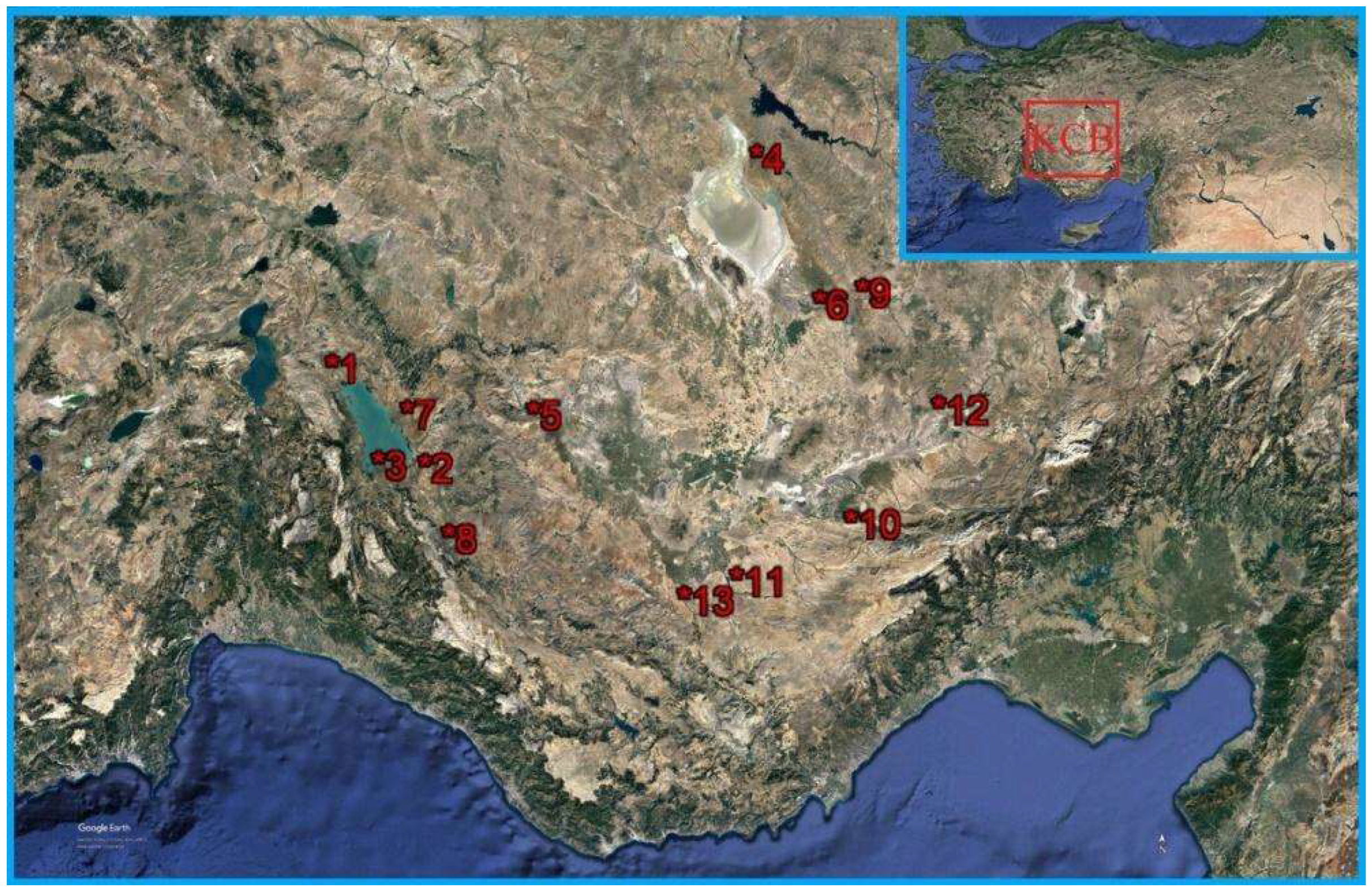
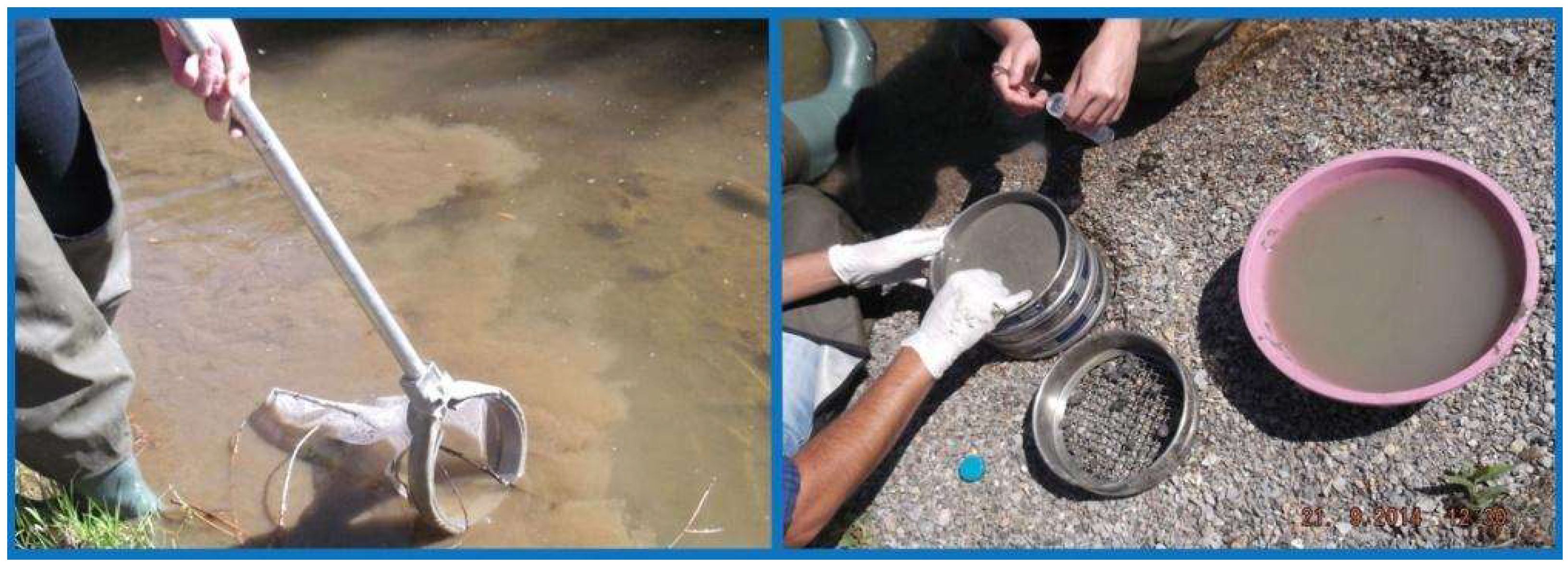

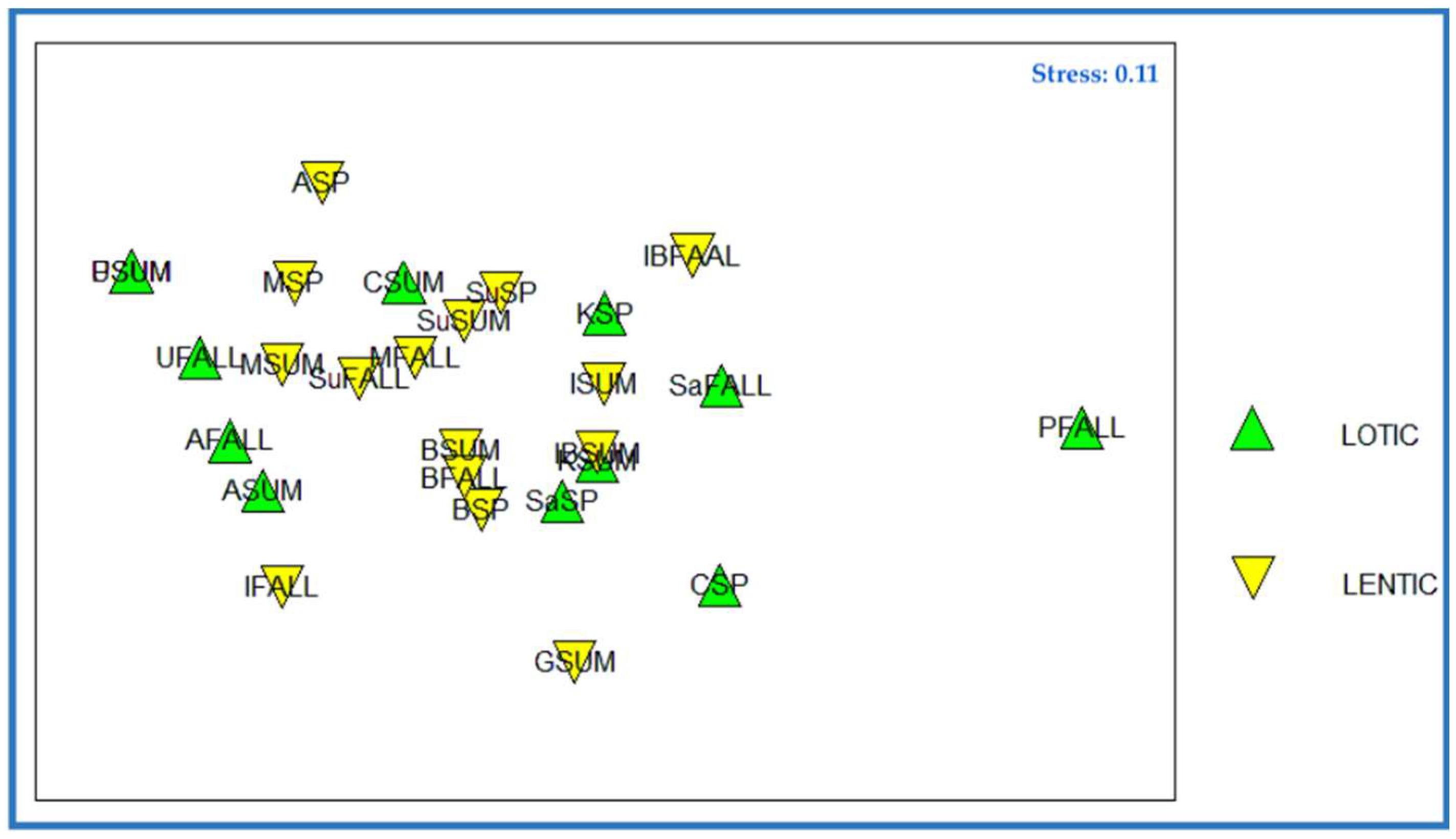

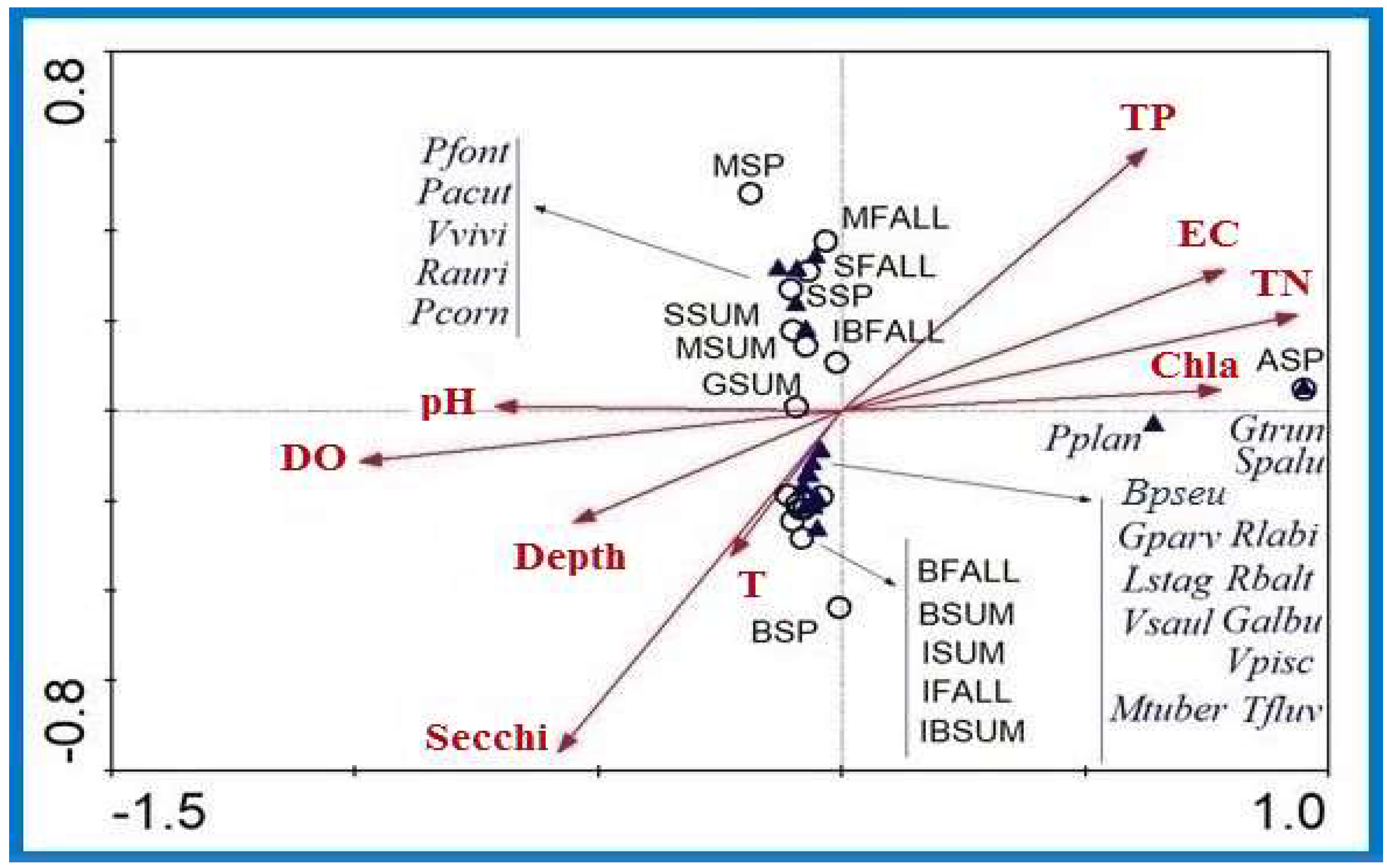



| Sampling Station | SN * | Type | Coordinates | Altitude (m) |
|---|---|---|---|---|
| Çeltik Canal | 1 | Lotic | 36.352149° S; 420.8687° W | 1113 |
| Sarısu Stream | 2 | Lotic | 36.388649° S; 417.4620° W | 1139 |
| Üstünler Stream | 3 | Lotic | 36.375542° S; 416.4616° W | 1123 |
| Peçeneközü Stream | 4 | Lotic | 36.547932° S; 431.1860° W | 969 |
| Konya City Center Stream | 5 | Lotic | 36.447585° S; 419.0054° W | 1136 |
| Aksaray Input | 6 | Lotic | 36.579699° S; 424.5333° W | 951 |
| Beyşehir Lake | 7 | Lentic | 36.380361° S; 417.7373° W | 1127 |
| Suğla Reservoir | 8 | Lentic | 36.409740° S 413.1782° W | 1116 |
| Mamasın Dam | 9 | Lentic | 36.599326° S; 425.1335° W | 1051 |
| İvriz Dam | 10 | Lentic | 36.602412° S; 414.4768° W | 1127 |
| İbrala Dam | 11 | Lentic | 36.536539° S; 411.6160° W | 1070 |
| Akkaya Dam | 12 | Lentic | 36.641739° S; 419.8598° W | 1191 |
| Gödet Dam | 13 | Lentic | 36.527060° S; 410.6125° W | 1110 |
| Parameter | Method | Device | LOD |
|---|---|---|---|
| Temperature (°C) | SM 2550 B | Multi-parameter water quality sensor (MPS) | - |
| pH | TS EN ISO 10523 | MPS | - |
| Electrical conductivity (µS c−1) | TS 9748 EN 27888 | MPS | - |
| Dissolved oxygen (mg L−1 O2) | TS EN 5814 | MPS | - |
| Light transmittance (m) | EPA Volunteer Stream | Secchi disc | - |
| Chlorophyll a (mg L−1) | SM 10200 H | Spectrophotometer | 0.001 |
| Total nitrogen (mg L−1 N) | SM 4500 NO2 B SM 4500 Norg B EPA METHOD 352-1 | -Nitrogen-Protein device -Spectrophotometer -Hot plate | 0.2 |
| Total phosphorus (mg L−1 P) | SM 4500 P B E | -Spectrophotometer -Hot plate | 0.01 |
| Total kjeldahl nitrogen (mg L−1) | SM 4500 Norg B | Nitrogen-Protein device | 0.2 |
| Nitrite (mg NO2−-N L−1) | SM 4500 NO2 B | Spectrophotometer | 0.002 |
| Nitrate (mg NO3−-N L−1) | EPA METHOD 352-1 | -Spectrophotometer -Hot plate | 0.1 |
| Species | Lotic Sites | Lentic Sites |
|---|---|---|
| Theodoxus anatolicus (Récluz, 1841) NER (PRO) | C | Ф |
| Theodoxus fluviatilis (Linnæus, 1758) NER (PRO) | C, S | B |
| Viviparus viviparus (Linnæus, 1758) CAE (PRO) | AI | SR, M |
| Melanoides tuberculata (O.F. Müller, 1774) CAE (PRO) | Ф | B |
| Bithynia pseudemmericia Schütt, 1964 CAE (PRO) | Ф | B |
| Potamopyrgus antipodarum (J.E. Gray, 1843) CAE (PRO) | S, P | Ф |
| Valvata piscinalis (O.F. Müller, 1774) HET (PRO) | AI | B |
| Valvata saulcyi Bourguignat, 1853 HET (PRO) | Ф | B |
| Galba truncatula (O.F. Müller, 1774) HET (PUL) | K | A |
| Stagnicola palustris (O.F. Müller, 1774) HET (PUL) | AI | A |
| Radix auricularia (Linnæus, 1758) HET (PUL) | Ф | SR |
| Peregriana labiata (Rossmässler, 1835) HET (PUL) | U, AI | B, SR, M, I |
| Ampullaceana balthica (Linnæus, 1758) HET (PUL) | C, S, K | B, SR, M, I, IB |
| Lymnaea stagnalis (Linnæus, 1758) HET (PUL) | Ф | B, G |
| Physa fontinalis (Linnæus, 1758) HET (PUL) | Ф | SR, M |
| Physella acuta (Draparnaud, 1805) HET (PUL) | C, U, P, AI | M |
| Planorbarius corneus (Linnæus, 1758) HET (PUL) | Ф | B, SR |
| Planorbis planorbis (Linnæus, 1758) HET (PUL) | Ф | B, A |
| Bathyomphalus contortus (Linnæus, 1758) HET (PUL) | C | Ф |
| Gyraulus albus (O.F. Müller, 1774) HET (PUL) | S, K | B, IB, G |
| Gyraulus piscinarum (Bourguignat, 1852) HET (PUL) | S, K | B, IB |
| Species | Çeltik | Sarısu | Üstünler | Peçeneközü | Konya C. | Aksaray | Σind | D% | F% |
|---|---|---|---|---|---|---|---|---|---|
| Bcont | 1 | 0 | 0 | 0 | 0 | 0 | 1 | 0.49 | 16.67 |
| Gtrun | 0 | 0 | 0 | 0 | 1 | 0 | 1 | 0.49 | 16.67 |
| Galbu | 0 | 2 | 0 | 0 | 5 | 0 | 7 | 3.45 | 33.33 |
| Gpisc | 0 | 12 | 0 | 0 | 17 | 0 | 29 | 14.29 | 33.33 |
| Pacut | 2 | 0 | 16 | 1 | 0 | 6 | 25 | 12.32 | 66.67 |
| Panti | 0 | 12 | 0 | 53 | 0 | 0 | 65 | 32.02 | 33.33 |
| Rbalt | 1 | 3 | 0 | 0 | 30 | 0 | 34 | 16.75 | 50 |
| Rlabi | 0 | 0 | 1 | 0 | 0 | 4 | 5 | 2.46 | 33.33 |
| Spalu | 0 | 0 | 0 | 0 | 0 | 4 | 4 | 1.97 | 16.67 |
| Tfluv | 1 | 5 | 0 | 0 | 0 | 0 | 6 | 2.96 | 33.33 |
| Tanat | 1 | 0 | 0 | 0 | 0 | 0 | 1 | 0.49 | 16.67 |
| Vpisc | 0 | 0 | 0 | 0 | 0 | 24 | 24 | 11.82 | 16.67 |
| Vvivi | 0 | 0 | 0 | 0 | 0 | 1 | 1 | 0.49 | 16.67 |
| S | 5 | 5 | 2 | 2 | 4 | 5 | |||
| N | 6 | 34 | 17 | 54 | 53 | 39 | Σ203 | ||
| d | 2.23 | 1.13 | 0.35 | 0.25 | 0.76 | 1.09 | |||
| J’ | 0.97 | 0.87 | 0.32 | 0.13 | 0.71 | 0.71 | |||
| H(loge) | 1.56 | 1.4 | 0.22 | 0.09 | 0.98 | 1.15 | |||
| 1-λ’ | 0.93 | 0.74 | 0.12 | 0.04 | 0.58 | 0.59 |
| Species | Beyşehir | Suğla | Mamasın | İvriz | İbrala | Akkaya | Gödet | Σind | D% | F% |
|---|---|---|---|---|---|---|---|---|---|---|
| Bpseu | 7 | 0 | 0 | 0 | 0 | 0 | 0 | 7 | 2.13 | 14.29 |
| Gtrun | 0 | 0 | 0 | 0 | 0 | 5 | 0 | 5 | 1.52 | 14.29 |
| Galbu | 7 | 0 | 0 | 0 | 2 | 0 | 4 | 13 | 3.96 | 42.86 |
| Gpisc | 3 | 0 | 0 | 0 | 2 | 0 | 0 | 5 | 1.52 | 28.57 |
| Lstag | 2 | 0 | 0 | 0 | 0 | 0 | 1 | 3 | 0.91 | 28.57 |
| Mtuber | 4 | 0 | 0 | 0 | 0 | 0 | 0 | 4 | 1.22 | 14.29 |
| Pfont | 0 | 16 | 8 | 0 | 0 | 0 | 0 | 24 | 7.32 | 28.57 |
| Pacut | 0 | 0 | 2 | 0 | 0 | 0 | 0 | 2 | 0.61 | 14.29 |
| Pcorn | 1 | 8 | 0 | 0 | 0 | 0 | 0 | 9 | 2.74 | 28.57 |
| Pplan | 1 | 0 | 0 | 0 | 0 | 4 | 0 | 5 | 1.52 | 28.57 |
| Rauri | 0 | 5 | 0 | 0 | 0 | 0 | 0 | 5 | 1.52 | 14.29 |
| Rbalt | 77 | 4 | 3 | 3 | 5 | 0 | 0 | 92 | 28.05 | 71.43 |
| Rlabi | 14 | 2 | 2 | 1 | 0 | 0 | 0 | 19 | 5.79 | 57.14 |
| Spalu | 0 | 0 | 0 | 0 | 0 | 13 | 0 | 13 | 3.96 | 14,29 |
| Tfluv | 13 | 0 | 0 | 0 | 0 | 0 | 0 | 13 | 3.96 | 14.29 |
| Vpisc | 12 | 1 | 0 | 0 | 0 | 0 | 0 | 13 | 3.96 | 28.57 |
| Vsaul | 2 | 0 | 0 | 0 | 0 | 0 | 0 | 2 | 0.61 | 14.29 |
| Vvivi | 0 | 43 | 51 | 0 | 0 | 0 | 0 | 94 | 28.66 | 28.57 |
| S | 12 | 7 | 5 | 2 | 3 | 3 | 2 | |||
| N | 143 | 79 | 66 | 4 | 9 | 22 | 5 | Σ328 | ||
| d | 2.22 | 1.37 | 0.95 | 0.72 | 0.91 | 0.65 | 0.62 | |||
| J’ | 0.66 | 0.7 | 0.5 | 0.81 | 0.91 | 0.87 | 0.72 | |||
| H(loge) | 1.65 | 1.36 | 0.81 | 0.56 | 1 | 0.96 | 0.5 | |||
| 1-λ’ | 0.68 | 0.65 | 0.39 | 0.5 | 0.67 | 0.59 | 0.4 |
| Station | WFD | TSWQR | EQS | Sp D | D% | MC D | Hub D |
|---|---|---|---|---|---|---|---|
| Çeltik | bad | Eutrophic | >mac | Pacut | 33 | 1 | eu, pe, tx, α-β |
| Sarısu | bad | Eutrophic | >mac | Gpisc | 35 | Ф | sw, po, ph |
| Panti | 35 | 5 | eu, sw, po, is | ||||
| Üstünler | poor | Hypertrophic | >mac | Pacu | 94 | ||
| Peçeneközü | poor | Eutrophic | >mac | Panti | 98 | ||
| Konya C. | bad | Eutrophic | >mac | Rbalt | 57 | Ф | sw, pe, po, ph |
| Aksaray | poor | Hypertrophic | >mac | Vpisc | 62 | 7 | sw, pe, po, ph, rh, xs |
| Beyşehir | poor | Mesotrophic | >mac | Rbalt | 54 | ||
| Suğla | bad | Eutrophic | >mac | Vvivi | 54 | 8 | sw, pe, po |
| Mamasın | bad | Eutrophic | >mac | Vvivi | 77 | ||
| İvriz | bad | Eutrophic | >mac | Rbalt | 75 | ||
| İbrala | bad | Hypertrophic | >mac | Rbalt | 56 | ||
| Akkaya | bad | Hypertrophic | >mac | Spalu | 59 | 4 | eu, pe, ph |
| Gödet | bad | Eutrophic | >mac | Galbu | 80 | 5 | sw, ph, po, rh |
Publisher’s Note: MDPI stays neutral with regard to jurisdictional claims in published maps and institutional affiliations. |
© 2022 by the authors. Licensee MDPI, Basel, Switzerland. This article is an open access article distributed under the terms and conditions of the Creative Commons Attribution (CC BY) license (https://creativecommons.org/licenses/by/4.0/).
Share and Cite
Gümüş, B.A.; Gürbüzer, P.; Altındağ, A. Towards a Sustainable World: Diversity of Freshwater Gastropods in Relation to Environmental Factors—A Case in the Konya Closed Basin, Türkiye. Diversity 2022, 14, 934. https://doi.org/10.3390/d14110934
Gümüş BA, Gürbüzer P, Altındağ A. Towards a Sustainable World: Diversity of Freshwater Gastropods in Relation to Environmental Factors—A Case in the Konya Closed Basin, Türkiye. Diversity. 2022; 14(11):934. https://doi.org/10.3390/d14110934
Chicago/Turabian StyleGümüş, Burçin Aşkım, Pınar Gürbüzer, and Ahmet Altındağ. 2022. "Towards a Sustainable World: Diversity of Freshwater Gastropods in Relation to Environmental Factors—A Case in the Konya Closed Basin, Türkiye" Diversity 14, no. 11: 934. https://doi.org/10.3390/d14110934
APA StyleGümüş, B. A., Gürbüzer, P., & Altındağ, A. (2022). Towards a Sustainable World: Diversity of Freshwater Gastropods in Relation to Environmental Factors—A Case in the Konya Closed Basin, Türkiye. Diversity, 14(11), 934. https://doi.org/10.3390/d14110934







